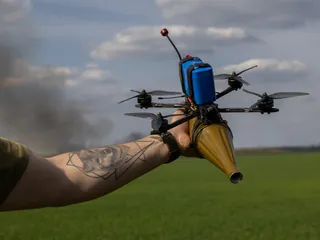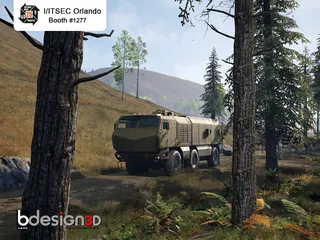Drone Warfare – Train Many, Train Fast
Contact Our Team
For more information about how Halldale can add value to your marketing and promotional campaigns or to discuss event exhibitor and sponsorship opportunities, contact our team to find out more
The Americas -
holly.foster@halldale.com
Rest of World -
jeremy@halldale.com

As drones redefine every domain of warfare, from Ukraine’s skies to the world’s seas and streets, simulation and training are key. MS&T’s Special Correspondent Andy Fawkes reports.
From Weddings to War
Warfare is being rewritten in real time. Across Ukraine’s front lines and beyond, the transformation is in plain sight as uncrewed systems, air, land, and sea now dominate the battlespace. The word “drone” itself likely traces back to Britain’s 1930s Queen Bee gunnery target aircraft, but few could have imagined one day drones would change warfare. The drone technology once used to film weddings have been militarized and now hunts tanks and soldiers across Europe’s most intense battlefield, reflecting the convergence of consumer technology and military necessity.
Uncrewed Aerial Systems (UAS) now account for an estimated 60–80 per cent of casualties and destruction on the Ukraine battlefield. Ukraine has become what Professor David Dunn of the University of Birmingham describes as an “extraordinary dynamic laboratory” for drone warfare. Drones of all shapes and sizes have blurred the separation between the front line and the rear with the airspace over the battlefield becoming a zone of constant surveillance and ever-present threat of lethal strikes. This has not only altered military tactics but has also reshaped the economics of conflict, as drones are manufactured in millions.
Drones are advancing at a remarkable pace, increasing in sophistication, capability, lethality, and adaptability, while remaining significantly less expensive than traditional weapon systems. Their usage extends beyond state actors with non-state groups like Yemen's Houthis also deploying them in combat. According to a United Nations report, military drones are now in the arsenals of 118 countries and at least 65 non-state actors worldwide. This shift has not gone unnoticed. US Department of War Secretary Pete Hegseth recently described drones as “the biggest battlefield innovation in a generation.” The British Army’s 20-40-40 strategy envisions an 80 per cent uncrewed and remotely operated force by 2035, and EU leaders, alarmed by airspace incursions, are discussing a “drone wall.”
The challenge, however, is not just technological but educational. Soldiers, officers, and entire command structures must learn to think differently, and traditional training pipelines can no longer keep pace with innovation measured in weeks. Ukraine’s experience shows how digital innovation, simulation, and even gamified training are reshaping combat. The modern warfighter must be soldier, coder, pilot, tactician, and analyst and the organizations that support them must also adapt and fast.
Training Scale and Diversity
Across Ukraine, there are uncrewed systems of every scale. From palm-sized quadcopters to fixed-wing reconnaissance aircraft, jet-powered loitering munitions, tracked supply robots, and explosive surface vessels. This diversity has transformed the skills demanded of the modern warfighter. Operators must now master flight dynamics, electronic-warfare awareness, communications, and power management, often under fire.
The requirement is vast. Millions of drones have been deployed in Ukraine alone, and the systems are multiplying across the world. The US Department of War aims to integrate drone proficiency across all combat training by 2027, while Russia is reportedly forming a new branch of its armed forces dedicated entirely to drones, potentially employing more than 200,000 personnel.
Basic control of a consumer-grade quadcopter can be learned in hours, but combat-ready proficiency takes longer. Operators of unstable First-Person View (FPV) drones typically require around a month-long foundation course, followed by operational practice to reach tactical competence. “It’s not just about flying,” Martin Carr of simulation company AVS told me. “It’s about managing information, communication, and endurance. These are networked systems, not solo aircraft.” Indeed, although drone racing is valuable, other skills are required, many of which may have been gained through earlier video gaming.
Such scale, pace and diversity challenge existing training pipelines. Safety regulations can further restrict live practice as illustrated by the recent ban on drone flights over Salisbury Plain. To meet demand, militaries are turning to simulation and gaming technologies to compress learning cycles and expand access.
Live and Simulation
Many drone types are relatively inexpensive and hence training live training for them is cost effective, however, simulation offers scale, safety, and adaptability. A blended approach is being taken by the British Army’s Project RAPSTONE which requires recruits to complete at least fifteen hours of simulator training before flying a live drone.
Ukraine’s drone training ecosystem has expanded rapidly, combining simulation with short, intensive practical instruction. Programs vary by platform, but trainees learn to build, repair, arm, and operate drones, practicing maneuvers such as flying through vehicle hatches. Some time is devoted to live flight, with the rest focused on mapping, camouflage, and mission planning. The pre-war drone racing community, online tutorials, and YouTube guides have provided a foundation for self-learning and platforms like LiftOff and Drone Racing League on Steam are common for basic instruction.
Specialized centres such as Dronarium and Victory Drones now train thousands of operators, including soldiers, police, and emergency personnel. Courses range from weekend sessions to 100-hour FPV combat modules, supported by online content and field practice. Curricula also cover tactical medicine, mapping, and C2 combat software like Kropyva and Delta. Ukraine’s training ecosystem depends heavily on simulation and also functions as a digital laboratory. James Kenny of Stratacuity told me its importance goes beyond training, “it’s how new tactics and technologies are tested safely.” Some Ukrainian regiments now have in-house R&D teams feeding battlefield data back into simulation loops.
This training and operational convergence is also demonstrated by Ukraine’s Obriy Sim, virtual combat training environment built upon the Unreal Engine 5 (UE5). Replicating the real-world terrains of the Ukrainian battlefield, it is primarily used for tactical training and mission rehearsal, and it is gaining traction among some NATO nations, including the Dutch Task Force Drones, Carr told me.
Beyond Ukraine companies are building drone simulators. Nordfen, a Zurich-based startup is developing its simulator for Swiss militia personnel training using the Unity game engine. France’s TRYP FPV based on Unreal provides high fidelity drone physics, and as a game has sold quarter of million copies but also now supports the French army. The UK MetaverseVR’s VirtualSky also uses Unreal and includes an Instructor Operator Station for creating tailored scenarios and adding new UAVs. Military simulation providers are also responding. MAK Technologies, building on experience from projects such as the UK’s Watchkeeper UAV, offers an FPV drone simulator powered by VR-Forces and VR-Vantage providing customisable training for surveillance and tactical missions. Bohemia’s VBS4 is also adding more drone warfare capabilities with all major drone types and supports experimentation, TTP development, and training.
Gamification and the Psychology of Drone Warfare
Technology has changed not only how soldiers fight, but how they stay motivated. Ukraine’s Army of Drones bonus program has formally gamified combat, awarding points for confirmed kills, 6 points for a soldier, 40 for a tank, with the points redeemed for new equipment. A heavy bomber Vampire drone can be redeemed for 43 points for example. Beyond its use as a motivational tool, the Army of Drones program allows the high command in Kyiv to adjust the targets their forces prioritize. Mykhailo Fedorov, Ukraine’s Minister of Digital Transformation told Time Magazine “now we see it in real time and what’s working, what’s not.”
The widespread deployment of drones has altered the psychology of warfare as operators are physically removed from the killing, and the fighting can start to feel less real. However, this emotional distance carries a risk, as it can lead operators to prioritise accumulating kills, such as achieving at least something rather than wasting a drone, potentially overlooking mission changes or ethical restraints.
The Future of War
The future of warfare lies in the relationship between humans and machines. Remote and autonomous systems are extending the reach of combat, allowing operators to fight from great distances, but they are not eliminating the human presence. Autonomy promises faster decision-making and resilience against jamming, yet it raises unresolved technical, ethical, and strategic questions. Current defence trends point to a shift toward human–machine teaming, where algorithms process data and execute controls while people supply intent and judgement. Tomorrow’s soldier may oversee a swarm of semi-autonomous drones rather than fly one, serving more as mission coordinator than operator. Training, accordingly, is moving toward managing and supervising intelligent systems.
Yet even as autonomy advances, war still relies on human presence. Territory must be taken and held by people, not machines. Technology can deliver precision and information, but not legitimacy or control. Until machines can truly fight and decide alone, warfare will remain shaped by human choices and accountability.
What Next for the Military Training and Simulation Community?
Recent conflicts signal that the military simulation and training community must not only redouble its efforts in preparing warfighters for drone warfare but also better make the case of its importance at a strategic level. At a time of rapid innovation, highly centralised control could be unhelpful, but the drone training landscape remains fragmented, with many developers and a lack of coordination. Training and education must also extend beyond the warfighter to include engineers, planners, and policymakers. Future success will depend not only on drone numbers but on the ability to train and adapt with them.
Author’s Note: This article provides a snapshot of a fast-moving and complex field so many initiatives and companies may well not have been covered. However, I hope this article will encourage more reporting and discussions in future, ultimately to help prepare warfighters now and in future for this transformation in warfare.
Editor’s Note: Halldale is again pleased to have Andy Fawkes, our UK-based Special Correspondent, provide analysis and insights on a rapidly evolving defense S&T development. As the author noted, UAS training and operations are fast-moving activities. For instance, as this article was posted US Army was staffing plans to reduce investments in its manned rotary aircraft fleets and build more capacity in its UAS programs. We look forward to reporting on this and other related developments in the run-up and convening of I/ITSEC 2025.


